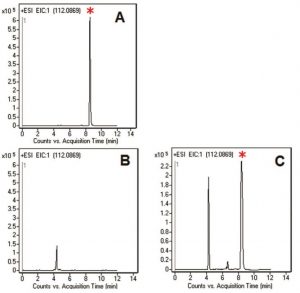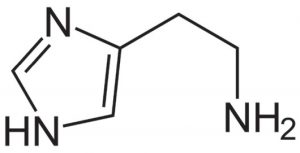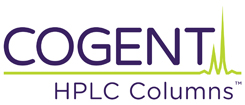LCMS Method without Derivatization
This Method is simple, fast, robust, and does not require derivatization, which is the main advantage over other HPLC Methods used in the Assay of this polar compound. It was demonstrated that Histamine is not present in the White Wine sample (Figure B). Sample preparation was minimal and involved just filtration using syringe filters. The sample of Red Wine contained Histamine at a level that was determined to be below 10mg / L (Figure C).


Method Conditions
Column: Cogent Diamond Hydride™, 4µm, 100Å
Catalog No.: 70000-15P-2
Dimensions: 2.1 x 150mm
Mobile Phase:
—A: 50% DI Water / 50% 2-Propanol / 0.1% Formic Acid
—B: Acetonitrile / 0.1% Formic Acid
Gradient:
| Time (minutes) | %B |
| 0 | 80 |
| 5 | 10 |
| 7 | 10 |
| 8 | 80 |
Post Time: 5 minutes (can be reduced for standards)
Injection vol.: 1µL
Flow rate: 0.4mL / minute
Detection: ESI – POS – Agilent 6210 MSD TOF Mass Spectrometer
Figures:
—A: Histamine Standard. 1mg / mL Histamine Dihydrochloride in DI Water / Methanol 80:20. The solution was filtered through a 0.45µm Filter (MicroSolv Tech Corp.). Sample for injection was diluted 1:100 with 50:50 Solvent A:B mixture. * = Histamine Peak
—B: White wine. The wine was filtered through a disposable 0.45µm Filter (MicroSolv Tech Corp.) and injected as is. No histamine peak. Extra peak is from wine matrix.
—C: Old red wine. The wine was filtered through a disposable 0.45µm Filter (MicroSolv Tech Corp.). Sample for injection was diluted 1:5 with 50:50 Solvent A:B mixture. * = Histamine Peak
Extra peaks are from wine matrix.
t0: 0.9 minutes
Note: Histamine is known for its role in allergic response. Release of Histamine plays a role in inflammation, gastric acid secretion, microcirculation and neurotransmission in mammalian brains. Measurement of Histamine levels in body fluids has been used in clinical analysis in various diseases such as Preeclampsia, Asthma, Cancer, Mastocytosis and in the progression of Periodontitis. Histamine is also present in many foods and beverages, especially red wine and spoiled food. Ingesting histamine can cause migraines, sweating and nausea.
Attachment
Histamine in red and white wine analyzed with LCMS pdf Download File


